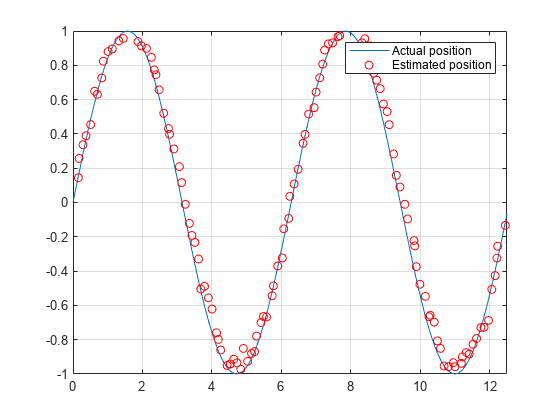stateEstimatorPF
Create particle filter state estimator
Description
The stateEstimatorPF object is a recursive, Bayesian state estimator
that uses discrete particles to approximate the posterior distribution of the estimated
state.
The particle filter algorithm computes the state estimate recursively and involves two steps: prediction and correction. The prediction step uses the previous state to predict the current state based on a given system model. The correction step uses the current sensor measurement to correct the state estimate. The algorithm periodically redistributes, or resamples, the particles in the state space to match the posterior distribution of the estimated state.
The estimated state consists of state variables. Each particle represents a discrete state hypothesis of these state variables. The set of all particles is used to help determine the final state estimate.
You can apply the particle filter to arbitrary nonlinear system models. Process and measurement noise can follow arbitrary non-Gaussian distributions.
For more information on the particle filter workflow and setting specific parameters, see:
Creation
Syntax
Description
pf = stateEstimatorPFinitialize method to initialize the
particles with a known mean and covariance or uniformly distributed particles
within defined bounds. To customize the particle filter’s system and measurement
models, modify the StateTransitionFcn and
MeasurementLikelihoodFcn properties.
After you create the object, use initialize to
initialize the NumStateVariables and
NumParticles properties. The initialize
function sets these two properties based on your inputs.
Properties
Object Functions
initialize | Initialize the state of the particle filter |
getStateEstimate | Extract best state estimate and covariance from particles |
predict | Predict state of robot in next time step |
correct | Adjust state estimate based on sensor measurement |
Examples
References
[1] Arulampalam, M.S., S. Maskell, N. Gordon, and T. Clapp. "A Tutorial on Particle Filters for Online Nonlinear/Non-Gaussian Bayesian Tracking." IEEE Transactions on Signal Processing. Vol. 50, No. 2, Feb 2002, pp. 174-188.
[2] Chen, Z. "Bayesian Filtering: From Kalman Filters to Particle Filters, and Beyond." Statistics. Vol. 182, No. 1, 2003, pp. 1-69.
Extended Capabilities
Version History
Introduced in R2016aSee Also
resamplingPolicyPF | initialize | getStateEstimate | predict | correct
Topics
- Track a Car-Like Robot Using Particle Filter (Robotics System Toolbox)
- Particle Filter Parameters
- Particle Filter Workflow
